brakes BMW 325XI SPORTS WAGON 2005 Owners Manual
[x] Cancel search | Manufacturer: BMW, Model Year: 2005, Model line: 325XI SPORTS WAGON, Model: BMW 325XI SPORTS WAGON 2005Pages: 178, PDF Size: 2.69 MB
Page 77 of 178
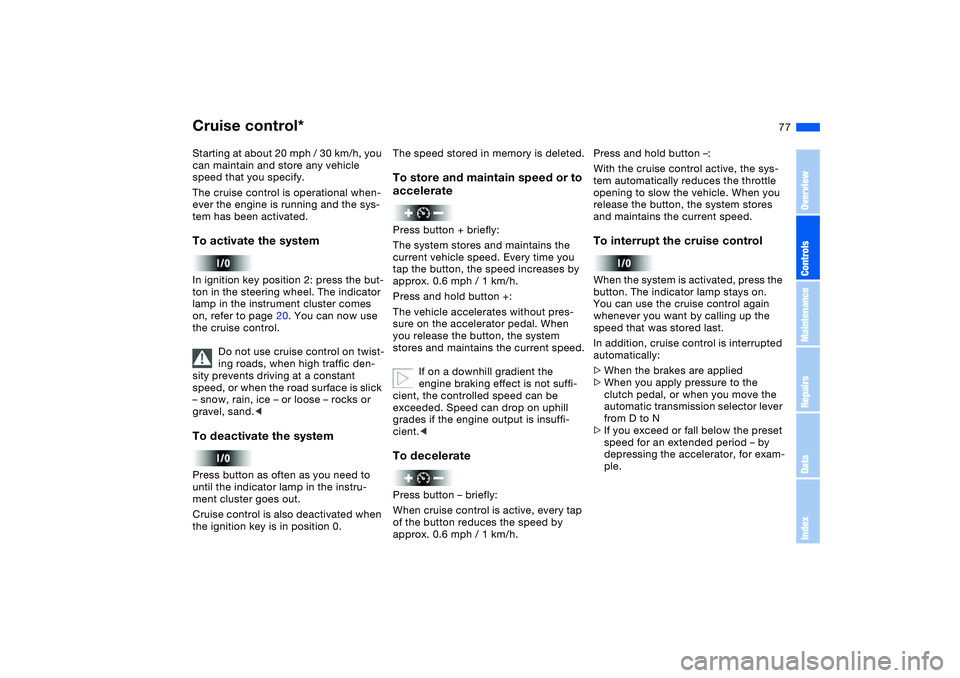
77
Cruise control*Starting at about 20 mph / 30 km/h, you
can maintain and store any vehicle
speed that you specify.
The cruise control is operational when-
ever the engine is running and the sys-
tem has been activated.To activate the systemIn ignition key position 2: press the but-
ton in the steering wheel. The indicator
lamp in the instrument cluster comes
on, refer to page 20. You can now use
the cruise control.
Do not use cruise control on twist-
ing roads, when high traffic den-
sity prevents driving at a constant
speed, or when the road surface is slick
– snow, rain, ice – or loose – rocks or
gravel, sand.
ment cluster goes out.
Cruise control is also deactivated when
the ignition key is in position 0.
The speed stored in memory is deleted.To store and maintain speed or to
acceleratePress button + briefly:
The system stores and maintains the
current vehicle speed. Every time you
tap the button, the speed increases by
approx. 0.6 mph / 1 km/h.
Press and hold button +:
The vehicle accelerates without pres-
sure on the accelerator pedal. When
you release the button, the system
stores and maintains the current speed.
If on a downhill gradient the
engine braking effect is not suffi-
cient, the controlled speed can be
exceeded. Speed can drop on uphill
grades if the engine output is insuffi-
cient.
of the button reduces the speed by
approx. 0.6 mph / 1 km/h.
Press and hold button –:
With the cruise control active, the sys-
tem automatically reduces the throttle
opening to slow the vehicle. When you
release the button, the system stores
and maintains the current speed.To interrupt the cruise controlWhen the system is activated, press the
button. The indicator lamp stays on.
You can use the cruise control again
whenever you want by calling up the
speed that was stored last.
In addition, cruise control is interrupted
automatically:
>When the brakes are applied
>When you apply pressure to the
clutch pedal, or when you move the
automatic transmission selector lever
from D to N
>If you exceed or fall below the preset
speed for an extended period – by
depressing the accelerator, for exam-
ple.
OverviewControlsMaintenanceRepairsDataIndex
Page 90 of 178
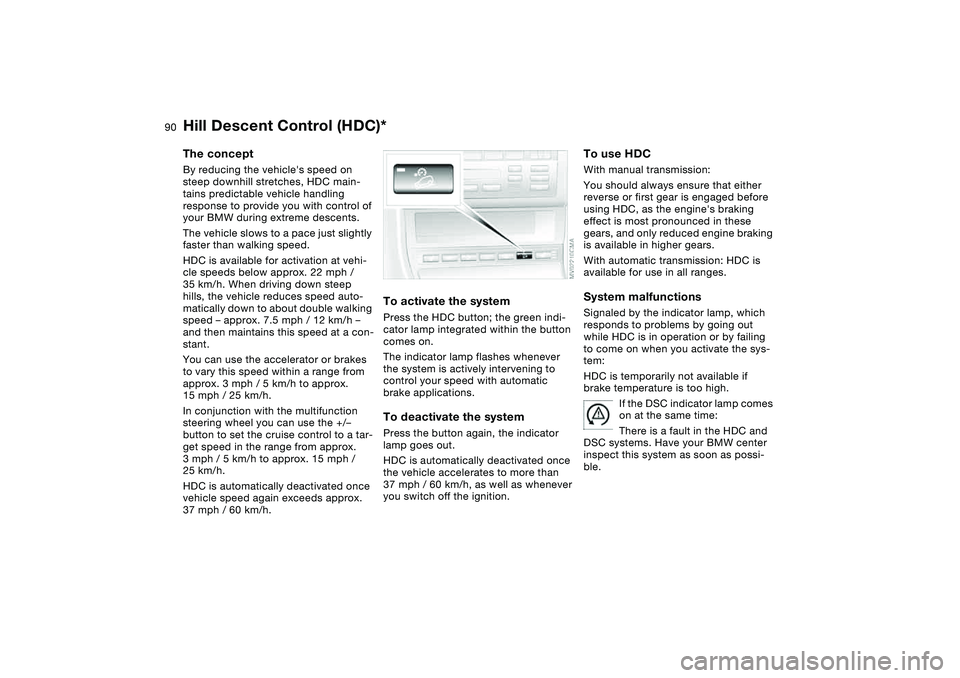
90
Hill Descent Control (HDC)*The conceptBy reducing the vehicle's speed on
steep downhill stretches, HDC main-
tains predictable vehicle handling
response to provide you with control of
your BMW during extreme descents.
The vehicle slows to a pace just slightly
faster than walking speed.
HDC is available for activation at vehi-
cle speeds below approx. 22 mph /
35 km/h. When driving down steep
hills, the vehicle reduces speed auto-
matically down to about double walking
speed – approx. 7.5 mph / 12 km/h –
and then maintains this speed at a con-
stant.
You can use the accelerator or brakes
to vary this speed within a range from
approx. 3 mph / 5 km/h to approx.
15 mph / 25 km/h.
In conjunction with the multifunction
steering wheel you can use the +/–
button to set the cruise control to a tar-
get speed in the range from approx.
3 mph / 5 km/h to approx. 15 mph /
25 km/h.
HDC is automatically deactivated once
vehicle speed again exceeds approx.
37 mph / 60 km/h.
To activate the systemPress the HDC button; the green indi-
cator lamp integrated within the button
comes on.
The indicator lamp flashes whenever
the system is actively intervening to
control your speed with automatic
brake applications.To deactivate the systemPress the button again, the indicator
lamp goes out.
HDC is automatically deactivated once
the vehicle accelerates to more than
37 mph / 60 km/h, as well as whenever
you switch off the ignition.
To use HDCWith manual transmission:
You should always ensure that either
reverse or first gear is engaged before
using HDC, as the engine's braking
effect is most pronounced in these
gears, and only reduced engine braking
is available in higher gears.
With automatic transmission: HDC is
available for use in all ranges.System malfunctionsSignaled by the indicator lamp, which
responds to problems by going out
while HDC is in operation or by failing
to come on when you activate the sys-
tem:
HDC is temporarily not available if
brake temperature is too high.
If the DSC indicator lamp comes
on at the same time:
There is a fault in the HDC and
DSC systems. Have your BMW center
inspect this system as soon as possi-
ble.
Page 121 of 178
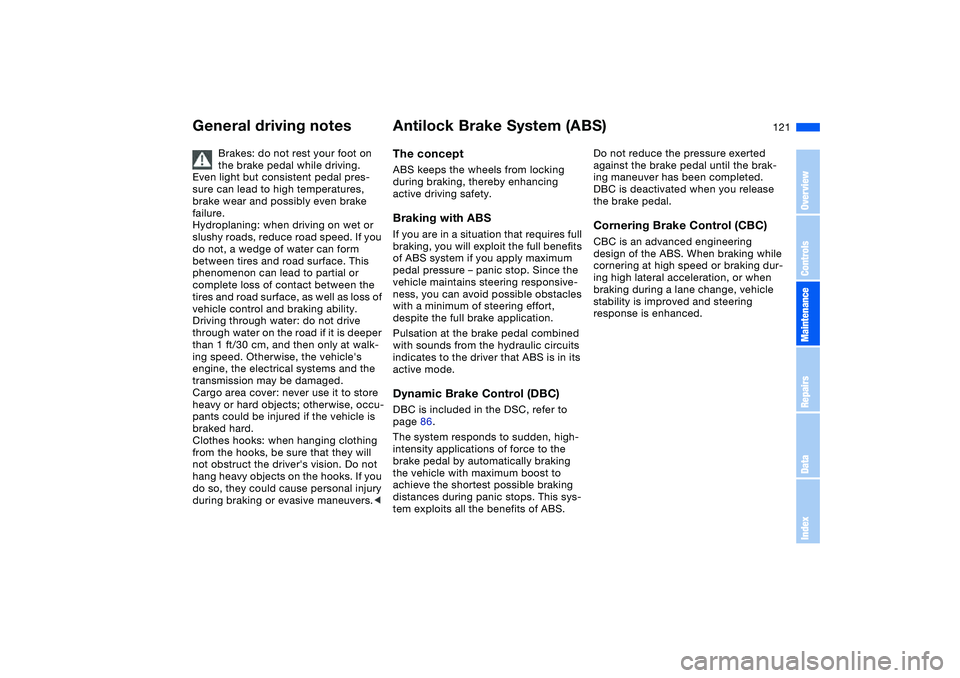
121
General driving notes
Brakes: do not rest your foot on
the brake pedal while driving.
Even light but consistent pedal pres-
sure can lead to high temperatures,
brake wear and possibly even brake
failure.
Hydroplaning: when driving on wet or
slushy roads, reduce road speed. If you
do not, a wedge of water can form
between tires and road surface. This
phenomenon can lead to partial or
complete loss of contact between the
tires and road surface, as well as loss of
vehicle control and braking ability.
Driving through water: do not drive
through water on the road if it is deeper
than 1 ft/30 cm, and then only at walk-
ing speed. Otherwise, the vehicle's
engine, the electrical systems and the
transmission may be damaged.
Cargo area cover: never use it to store
heavy or hard objects; otherwise, occu-
pants could be injured if the vehicle is
braked hard.
Clothes hooks: when hanging clothing
from the hooks, be sure that they will
not obstruct the driver's vision. Do not
hang heavy objects on the hooks. If you
do so, they could cause personal injury
during braking or evasive maneuvers.<
Antilock Brake System (ABS)The conceptABS keeps the wheels from locking
during braking, thereby enhancing
active driving safety.Braking with ABSIf you are in a situation that requires full
braking, you will exploit the full benefits
of ABS system if you apply maximum
pedal pressure – panic stop. Since the
vehicle maintains steering responsive-
ness, you can avoid possible obstacles
with a minimum of steering effort,
despite the full brake application.
Pulsation at the brake pedal combined
with sounds from the hydraulic circuits
indicates to the driver that ABS is in its
active mode.Dynamic Brake Control (DBC)DBC is included in the DSC, refer to
page 86.
The system responds to sudden, high-
intensity applications of force to the
brake pedal by automatically braking
the vehicle with maximum boost to
achieve the shortest possible braking
distances during panic stops. This sys-
tem exploits all the benefits of ABS.Do not reduce the pressure exerted
against the brake pedal until the brak-
ing maneuver has been completed.
DBC is deactivated when you release
the brake pedal.
Cornering Brake Control (CBC)CBC is an advanced engineering
design of the ABS. When braking while
cornering at high speed or braking dur-
ing high lateral acceleration, or when
braking during a lane change, vehicle
stability is improved and steering
response is enhanced.
OverviewControlsMaintenanceRepairsDataIndex
Page 122 of 178
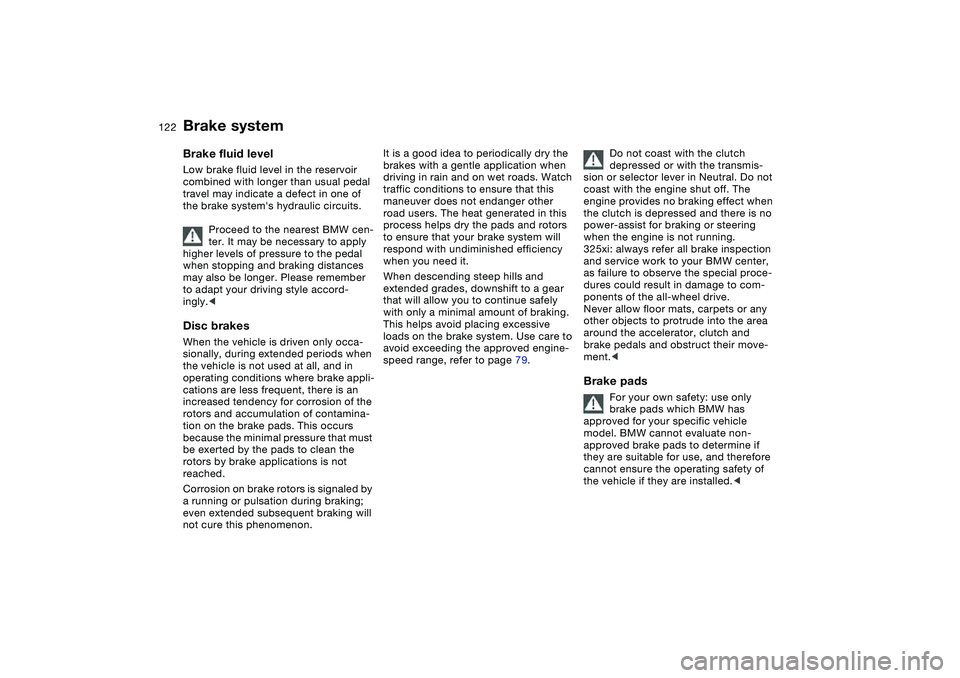
122
Brake systemBrake fluid levelLow brake fluid level in the reservoir
combined with longer than usual pedal
travel may indicate a defect in one of
the brake system's hydraulic circuits.
Proceed to the nearest BMW cen-
ter. It may be necessary to apply
higher levels of pressure to the pedal
when stopping and braking distances
may also be longer. Please remember
to adapt your driving style accord-
ingly.
the vehicle is not used at all, and in
operating conditions where brake appli-
cations are less frequent, there is an
increased tendency for corrosion of the
rotors and accumulation of contamina-
tion on the brake pads. This occurs
because the minimal pressure that must
be exerted by the pads to clean the
rotors by brake applications is not
reached.
Corrosion on brake rotors is signaled by
a running or pulsation during braking;
even extended subsequent braking will
not cure this phenomenon.
It is a good idea to periodically dry the
brakes with a gentle application when
driving in rain and on wet roads. Watch
traffic conditions to ensure that this
maneuver does not endanger other
road users. The heat generated in this
process helps dry the pads and rotors
to ensure that your brake system will
respond with undiminished efficiency
when you need it.
When descending steep hills and
extended grades, downshift to a gear
that will allow you to continue safely
with only a minimal amount of braking.
This helps avoid placing excessive
loads on the brake system. Use care to
avoid exceeding the approved engine-
speed range, refer to page 79.Do not coast with the clutch
depressed or with the transmis-
sion or selector lever in Neutral. Do not
coast with the engine shut off. The
engine provides no braking effect when
the clutch is depressed and there is no
power-assist for braking or steering
when the engine is not running.
325xi: always refer all brake inspection
and service work to your BMW center,
as failure to observe the special proce-
dures could result in damage to com-
ponents of the all-wheel drive.
Never allow floor mats, carpets or any
other objects to protrude into the area
around the accelerator, clutch and
brake pedals and obstruct their move-
ment.<
Brake pads
For your own safety: use only
brake pads which BMW has
approved for your specific vehicle
model. BMW cannot evaluate non-
approved brake pads to determine if
they are suitable for use, and therefore
cannot ensure the operating safety of
the vehicle if they are installed.<
Page 167 of 178
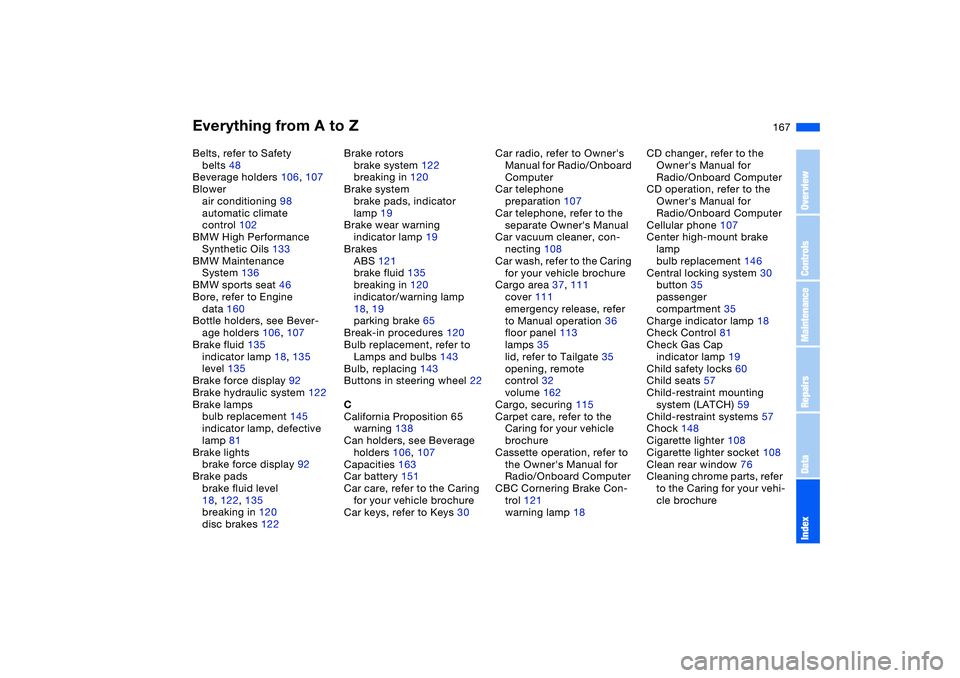
Everything from A to Z
167
Belts, refer to Safety
belts 48
Beverage holders 106, 107
Blower
air conditioning 98
automatic climate
control 102
BMW High Performance
Synthetic Oils 133
BMW Maintenance
System 136
BMW sports seat 46
Bore, refer to Engine
data 160
Bottle holders, see Bever-
age holders 106, 107
Brake fluid 135
indicator lamp 18, 135
level 135
Brake force display 92
Brake hydraulic system 122
Brake lamps
bulb replacement 145
indicator lamp, defective
lamp 81
Brake lights
brake force display 92
Brake pads
brake fluid level
18, 122, 135
breaking in 120
disc brakes 122Brake rotors
brake system 122
breaking in 120
Brake system
brake pads, indicator
lamp 19
Brake wear warning
indicator lamp 19
Brakes
ABS 121
brake fluid 135
breaking in 120
indicator/warning lamp
18, 19
parking brake 65
Break-in procedures 120
Bulb replacement, refer to
Lamps and bulbs 143
Bulb, replacing 143
Buttons in steering wheel 22
C
California Proposition 65
warning 138
Can holders, see Beverage
holders 106, 107
Capacities 163
Car battery 151
Car care, refer to the Caring
for your vehicle brochure
Car keys, refer to Keys 30Car radio, refer to Owner's
Manual for Radio/Onboard
Computer
Car telephone
preparation 107
Car telephone, refer to the
separate Owner's Manual
Car vacuum cleaner, con-
necting 108
Car wash, refer to the Caring
for your vehicle brochure
Cargo area 37, 111
cover 111
emergency release, refer
to Manual operation 36
floor panel 113
lamps 35
lid, refer to Tailgate 35
opening, remote
control 32
volume 162
Cargo, securing 115
Carpet care, refer to the
Caring for your vehicle
brochure
Cassette operation, refer to
the Owner's Manual for
Radio/Onboard Computer
CBC Cornering Brake Con-
trol 121
warning lamp 18CD changer, refer to the
Owner's Manual for
Radio/Onboard Computer
CD operation, refer to the
Owner's Manual for
Radio/Onboard Computer
Cellular phone 107
Center high-mount brake
lamp
bulb replacement 146
Central locking system 30
button 35
passenger
compartment 35
Charge indicator lamp 18
Check Control 81
Check Gas Cap
indicator lamp 19
Child safety locks 60
Child seats 57
Child-restraint mounting
system (LATCH) 59
Child-restraint systems 57
Chock 148
Cigarette lighter 108
Cigarette lighter socket 108
Clean rear window 76
Cleaning chrome parts, refer
to the Caring for your vehi-
cle brochure
OverviewControlsMaintenanceRepairsDataIndex
Page 168 of 178
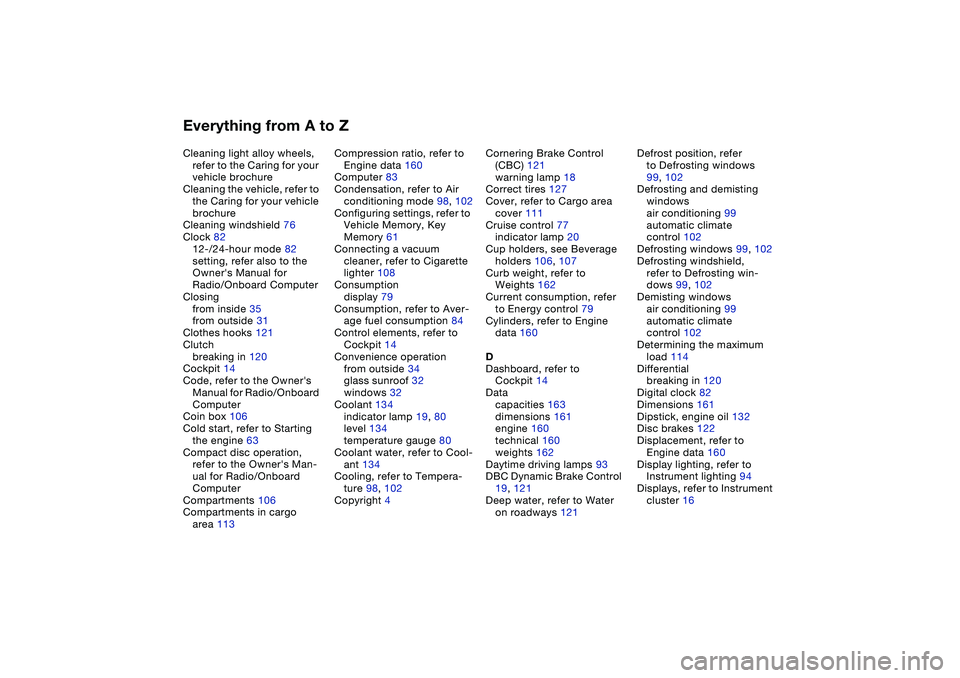
Everything from A to ZCleaning light alloy wheels,
refer to the Caring for your
vehicle brochure
Cleaning the vehicle, refer to
the Caring for your vehicle
brochure
Cleaning windshield 76
Clock 82
12-/24-hour mode 82
setting, refer also to the
Owner's Manual for
Radio/Onboard Computer
Closing
from inside 35
from outside 31
Clothes hooks 121
Clutch
breaking in 120
Cockpit 14
Code, refer to the Owner's
Manual for Radio/Onboard
Computer
Coin box 106
Cold start, refer to Starting
the engine 63
Compact disc operation,
refer to the Owner's Man-
ual for Radio/Onboard
Computer
Compartments 106
Compartments in cargo
area 113Compression ratio, refer to
Engine data 160
Computer 83
Condensation, refer to Air
conditioning mode 98, 102
Configuring settings, refer to
Vehicle Memory, Key
Memory 61
Connecting a vacuum
cleaner, refer to Cigarette
lighter 108
Consumption
display 79
Consumption, refer to Aver-
age fuel consumption 84
Control elements, refer to
Cockpit 14
Convenience operation
from outside 34
glass sunroof 32
windows 32
Coolant 134
indicator lamp 19, 80
level 134
temperature gauge 80
Coolant water, refer to Cool-
ant 134
Cooling, refer to Tempera-
ture 98, 102
Copyright 4Cornering Brake Control
(CBC) 121
warning lamp 18
Correct tires 127
Cover, refer to Cargo area
cover 111
Cruise control 77
indicator lamp 20
Cup holders, see Beverage
holders 106, 107
Curb weight, refer to
Weights 162
Current consumption, refer
to Energy control 79
Cylinders, refer to Engine
data 160
D
Dashboard, refer to
Cockpit 14
Data
capacities 163
dimensions 161
engine 160
technical 160
weights 162
Daytime driving lamps 93
DBC Dynamic Brake Control
19, 121
Deep water, refer to Water
on roadways 121Defrost position, refer
to Defrosting windows
99, 102
Defrosting and demisting
windows
air conditioning 99
automatic climate
control 102
Defrosting windows 99, 102
Defrosting windshield,
refer to Defrosting win-
dows 99, 102
Demisting windows
air conditioning 99
automatic climate
control 102
Determining the maximum
load 114
Differential
breaking in 120
Digital clock 82
Dimensions 161
Dipstick, engine oil 132
Disc brakes 122
Displacement, refer to
Engine data 160
Display lighting, refer to
Instrument lighting 94
Displays, refer to Instrument
cluster 16
Page 170 of 178
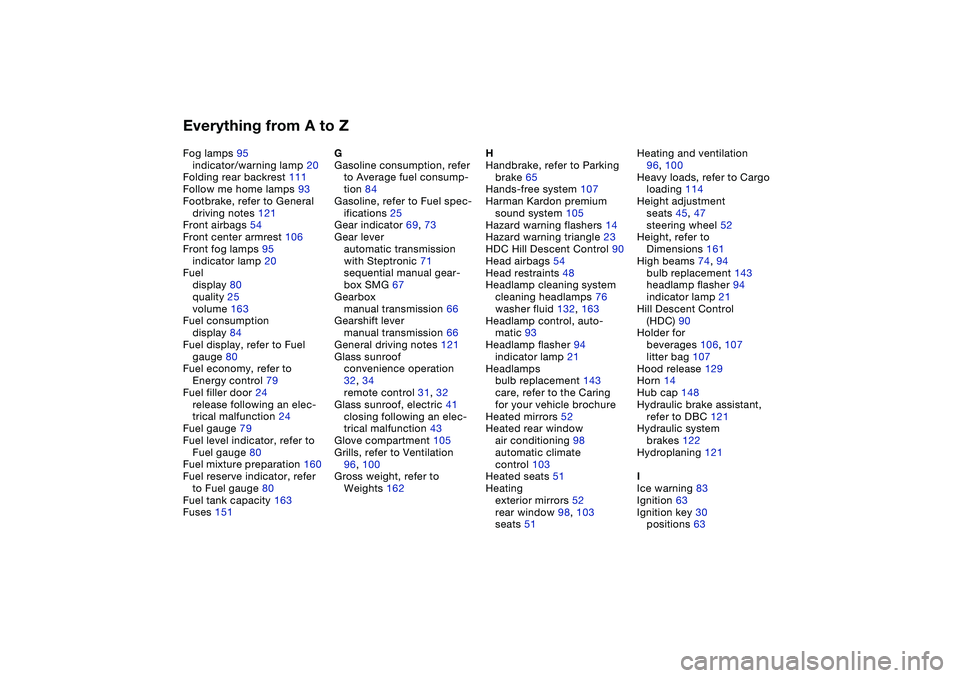
Everything from A to ZFog lamps 95
indicator/warning lamp 20
Folding rear backrest 111
Follow me home lamps 93
Footbrake, refer to General
driving notes 121
Front airbags 54
Front center armrest 106
Front fog lamps 95
indicator lamp 20
Fuel
display 80
quality 25
volume 163
Fuel consumption
display 84
Fuel display, refer to Fuel
gauge 80
Fuel economy, refer to
Energy control 79
Fuel filler door 24
release following an elec-
trical malfunction 24
Fuel gauge 79
Fuel level indicator, refer to
Fuel gauge 80
Fuel mixture preparation 160
Fuel reserve indicator, refer
to Fuel gauge 80
Fuel tank capacity 163
Fuses 151G
Gasoline consumption, refer
to Average fuel consump-
tion 84
Gasoline, refer to Fuel spec-
ifications 25
Gear indicator 69, 73
Gear lever
automatic transmission
with Steptronic 71
sequential manual gear-
box SMG 67
Gearbox
manual transmission 66
Gearshift lever
manual transmission 66
General driving notes 121
Glass sunroof
convenience operation
32, 34
remote control 31, 32
Glass sunroof, electric 41
closing following an elec-
trical malfunction 43
Glove compartment 105
Grills, refer to Ventilation
96, 100
Gross weight, refer to
Weights 162H
Handbrake, refer to Parking
brake 65
Hands-free system 107
Harman Kardon premium
sound system 105
Hazard warning flashers 14
Hazard warning triangle 23
HDC Hill Descent Control 90
Head airbags 54
Head restraints 48
Headlamp cleaning system
cleaning headlamps 76
washer fluid 132, 163
Headlamp control, auto-
matic 93
Headlamp flasher 94
indicator lamp 21
Headlamps
bulb replacement 143
care, refer to the Caring
for your vehicle brochure
Heated mirrors 52
Heated rear window
air conditioning 98
automatic climate
control 103
Heated seats 51
Heating
exterior mirrors 52
rear window 98, 103
seats 51Heating and ventilation
96, 100
Heavy loads, refer to Cargo
loading 114
Height adjustment
seats 45, 47
steering wheel 52
Height, refer to
Dimensions 161
High beams 74, 94
bulb replacement 143
headlamp flasher 94
indicator lamp 21
Hill Descent Control
(HDC) 90
Holder for
beverages 106, 107
litter bag 107
Hood release 129
Horn 14
Hub cap 148
Hydraulic brake assistant,
refer to DBC 121
Hydraulic system
brakes 122
Hydroplaning 121
I
Ice warning 83
Ignition 63
Ignition key 30
positions 63
Page 171 of 178
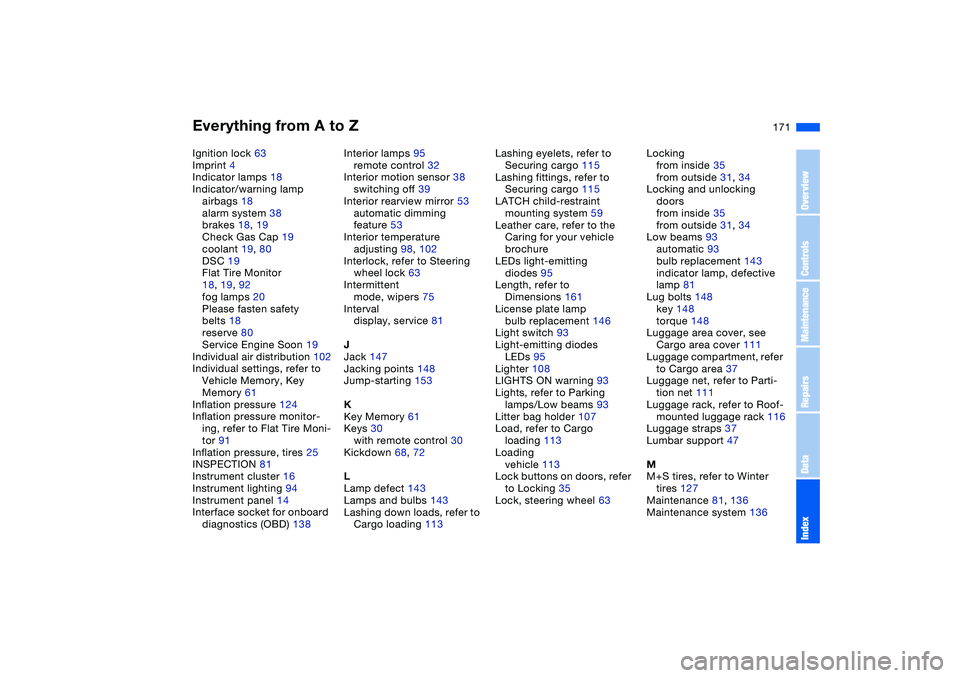
Everything from A to Z
171
Ignition lock 63
Imprint 4
Indicator lamps 18
Indicator/warning lamp
airbags 18
alarm system 38
brakes 18, 19
Check Gas Cap 19
coolant 19, 80
DSC 19
Flat Tire Monitor
18, 19, 92
fog lamps 20
Please fasten safety
belts 18
reserve 80
Service Engine Soon 19
Individual air distribution 102
Individual settings, refer to
Vehicle Memory, Key
Memory 61
Inflation pressure 124
Inflation pressure monitor-
ing, refer to Flat Tire Moni-
tor 91
Inflation pressure, tires 25
INSPECTION 81
Instrument cluster 16
Instrument lighting 94
Instrument panel 14
Interface socket for onboard
diagnostics (OBD) 138Interior lamps 95
remote control 32
Interior motion sensor 38
switching off 39
Interior rearview mirror 53
automatic dimming
feature 53
Interior temperature
adjusting 98, 102
Interlock, refer to Steering
wheel lock 63
Intermittent
mode, wipers 75
Interval
display, service 81
J
Jack 147
Jacking points 148
Jump-starting 153
K
Key Memory 61
Keys 30
with remote control 30
Kickdown 68, 72
L
Lamp defect 143
Lamps and bulbs 143
Lashing down loads, refer to
Cargo loading 113Lashing eyelets, refer to
Securing cargo 115
Lashing fittings, refer to
Securing cargo 115
LATCH child-restraint
mounting system 59
Leather care, refer to the
Caring for your vehicle
brochure
LEDs light-emitting
diodes 95
Length, refer to
Dimensions 161
License plate lamp
bulb replacement 146
Light switch 93
Light-emitting diodes
LEDs 95
Lighter 108
LIGHTS ON warning 93
Lights, refer to Parking
lamps/Low beams 93
Litter bag holder 107
Load, refer to Cargo
loading 113
Loading
vehicle 113
Lock buttons on doors, refer
to Locking 35
Lock, steering wheel 63Locking
from inside 35
from outside 31, 34
Locking and unlocking
doors
from inside 35
from outside 31, 34
Low beams 93
automatic 93
bulb replacement 143
indicator lamp, defective
lamp 81
Lug bolts 148
key 148
torque 148
Luggage area cover, see
Cargo area cover 111
Luggage compartment, refer
to Cargo area 37
Luggage net, refer to Parti-
tion net 111
Luggage rack, refer to Roof-
mounted luggage rack 116
Luggage straps 37
Lumbar support 47
M
M+S tires, refer to Winter
tires 127
Maintenance 81, 136
Maintenance system 136
OverviewControlsMaintenanceRepairsDataIndex